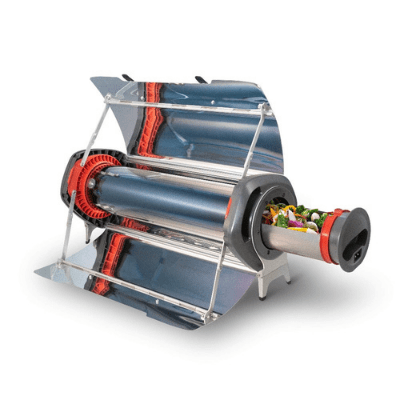
GoSun Fusion
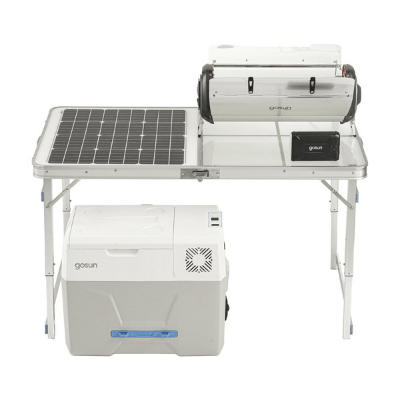
GoSun Original Solar Kitchen
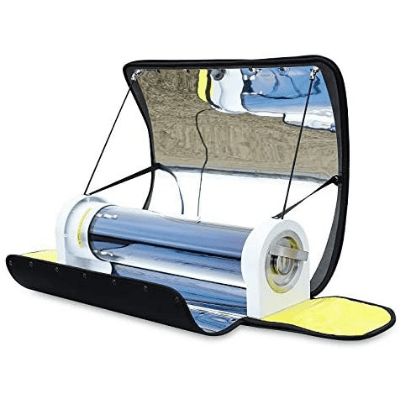
MrMapMax Solar Oven Portable
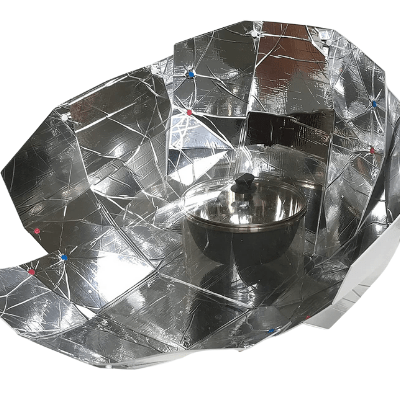
Haines 2.0 SunUp Solar Cooker and Dutch Oven Kit
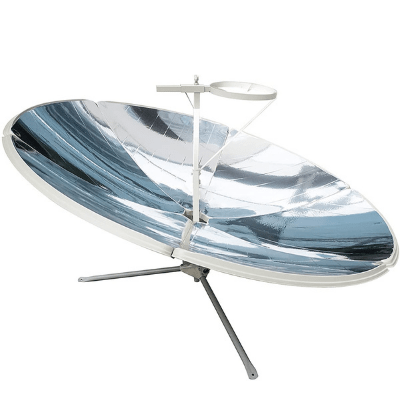
LiuWHweiXunDa Outdoor Ovens, Solar Cooker Stove Kits
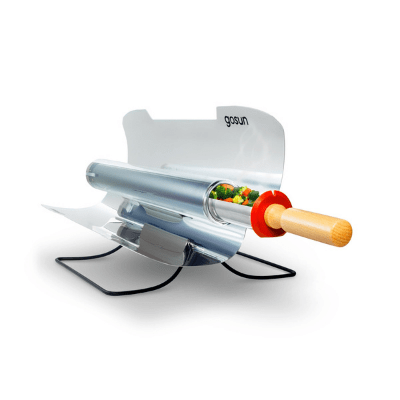
GoSun Sports Pro

Sunflair Portable Solar Oven Deluxe with Complete Cookware
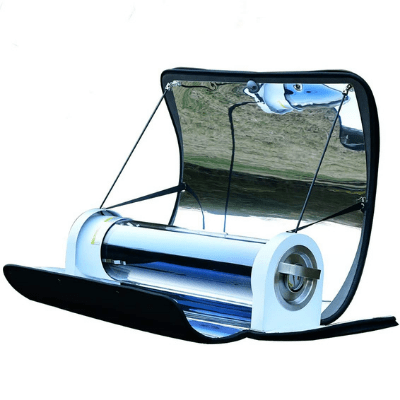
KECOP Portable BBQ Grill Solar BBQ Cooker
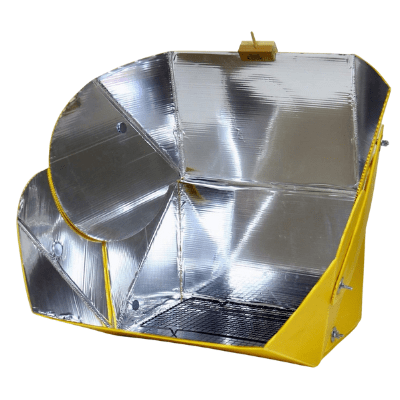
SolCook All Season Solar Cooker Camper
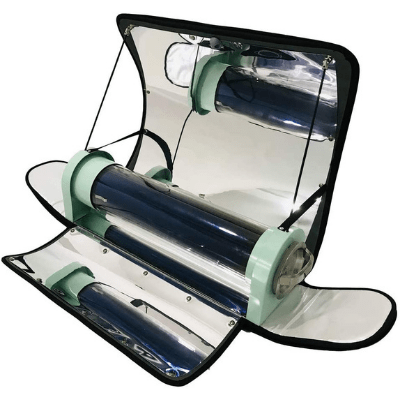
ETE ETMATE Solar Oven Outdoor Integrated Solar Cooker
Using a solar stove is the cleanest and easiest way of cooking delicious and healthy meals off the grid. Here are our unbiased reviews of this year’s top picks.
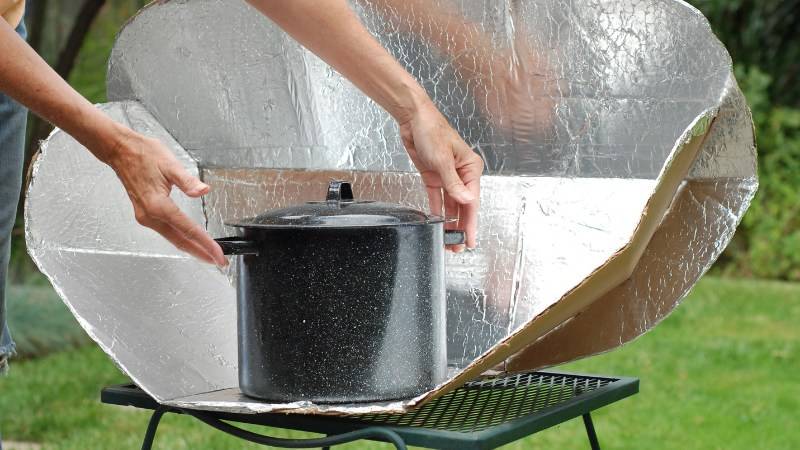
It’s high summer and you’ve just set up a campsite. Maybe cast a couple of lines into the creek. Now it’s a good time to fry some chicken or cook some sausages and beans for the hungry buddies.
You could gather some logs and start a fire, but there’s the problem. Fewer parks and nature reserves nowadays allow visitors to build open fires, and with wildfires raging in all parts of the globe, you don't want to risk it.
So what can you do?
You can set up your solar stove and whip up that tasty dinner before the sun touches the treeline.
10 Best Solar Stoves Reviewed
1. GoSun Fusion
When I saw a neighbor using this Cadillac of solar stoves, I knew I had to get one. First of all, the cooking times are highly efficient, and when you're on a camping trip, it's very convenient for cooking later in the day.
Compared to other models that I have used, this one generates the right amount of heat in a much shorter time.
In sunny conditions, that's possible in less than 30 minutes.
But there's also a very convenient backup.
If you run out of sunshine, you can switch to an electric energy source, ideally a solar battery, and continue cooking.
With the right size of solar panel and battery pack, you should be able to continue eco-friendly cooking.
And with the compartments for baking, cooking, and steaming food, you'll have no excuse to make your favorite foods.
All I needed was a few different-sized trays and getting used to adjusting the heat, and we had fresh bread and all meals sorted on a camping trip.
Pros
Cons
Why Do I Like It?
It's ideal if you want to cook later in the day where you might run out of sunshine as it allows you to switch to electric power sources.
2. GoSun Original Solar Kitchen
This solar kitchen is probably the most integrated solution you can find for working off the grid.
It's popular with preppers, the main reason being that it allows you to not only cook the food, but keep it cold as well.
It's not a huge cooling compartment, but it's ideal for storing things like meat to keep it fresh.
There are solar panels built into the table, but you can also order extra ones to charge more batteries as a backup. And I would definitely recommend adding that to your order.
On a camping trip, this could give you more power to add another travel cooler for drinks as well.
It can come in handy when you have some phones and tablets to charge at the end of the day as well.
From a cooking perspective, it's as efficient and effective as the Fusion one above.
Pros
Cons
Why Do I Like It?
It's a great option for cooking and cooling completely off the grid with included solar panels and batteries.
3. MrMapMax Solar Oven Portable
This is another model that I've tried a few times, and I like that it has a large cooking compartment.
There should be more than enough space to roast meat and vegetables and at the same time prepare a family meal.
It only takes about 40 minutes to reach some serious cooking temperatures even when it's not very sunny.
That's impressive and gave me a lot of flexibility when the sun kept hiding behind the clouds.
One reason this product is so popular is that it all folds up into a small package and fits into a storage bag that makes it very easy for camping trips.
I found that it wasn't a tight squeeze either, so the device always packs up into a neat package.
Pros
Cons
Why Do I Like It?
It's one of the most compact solar stoves for cooking larger volumes of food, making it suitable for any kind of camping trip.
4. Haines 2.0 SunUp Solar Cooker and Dutch Oven Kit
This is my go-to solar stove for any overnight hiking trips.
The great thing is that the temperatures get hot enough to cook food, but not so hot that you have to constantly monitor it to keep it from getting too hot.
That means you can set it up and go do other fun things with your family and friends without the worry of burning your food.
With a bit of practice, you'll quickly learn how to adjust the reflective panels for the temperature you need.
And, even kids can have some fun with it.
I would suggest buying more than one so that you can cook different things at the same time for larger groups as well.
Pros
Cons
Why Do I Like It?
It's the most basic option available that still creates powerful heat, making it an ideal option for hiking trips.
5. LiuWHweiXunDa Outdoor Ovens, Solar Cooker Stove Kits
This stove looks like a satellite dish, but that shape design is ideal for focusing sunlight into one precise spot.
The curve means that a large area of sunshine gets bundled into just a few inches.
The result is concentrated heat that you can use to cook food and boil water.
And because of this design, you can easily turn and tilt the mirrors for the best angle to the sun and the fastest heating times. When I tried it first, I just set a repeating timer for 30 minutes and then slightly adjusted the device towards the sun.
Compared to the other options above, it’s not going to allow you to host meals for large groups.
But because it’s lightweight — there’s no reason why you couldn’t carry a few of them on a trip.
Pros
Cons
Why Do I Like It?
Ideal for preparing small portions of food with a highly directed heat source.
6. GoSun Sports Pro
If you like the idea of the GoSun Fusion stove above but want something that is more portable and convenient, then this Sports version might just be what you're looking for.
It's a little bit cheaper but still highly effective.
You get the same design idea and the highly effective cooking compartment even on cloudy days.
But it's a lot smaller and lighter, making it ideal for carrying around, possibly even on a short hiking trip.
Cooking food for two people could take as little as 30 minutes in the midday sun, which I find works well for a lunch break on a hiking trip.
I usually prepare some of the food in the morning or the night before and then just set up the stove when I feel that the sun angle is ideal.
Pros
Cons
Why Do I Like It?
It's the small brother of the Fusion device I recommend above, which makes it more suitable for carrying in luggage.
7. Sunflair Portable Solar Oven Deluxe with Complete Cookware
For campers and hikers who like to travel light and where every pound of weight is carefully measured, this Sunflair device could be the ideal solution.
Yes, it comes with a load of cookware as well, but the reflective solar heater weighs only about a pound and easily folds down into the size of a cushion.
For simple meals, you could also have enough space to cook for up to eight people. But keep in mind that it doesn't get hot enough for roasting food.
On some trips, I have packed two of these, and that has allowed me to cook more food and in a shorter time. Adding the extra pound of weight really paid off with the faster food prep time.
I also liked using the dehydrating racks that you can use to make some jerky that you can have as a snack for the next day.
Pros
Cons
Why Do I Like It?
It's probably the lightest and easiest device to pack up for longer hiking trips.
8. KECOP Portable BBQ Grill Solar BBQ Cooker
When you're planning to cook for larger groups of people, then this could be an ideal option.
Yes, it's not small enough to carry around, but if you're heading on a trip by car or RV, then the extra cooking space will be ideal.
The main food chamber is vacuum-sealed, which I found really helped to keep the temperatures inside a lot more consistent as compared to other stoves.
There's also a tripod included that makes it a lot easier to position the stove just right to achieve maximum temps for grilling some delicious food.
Simply adjust the angle towards the sun every 30 minutes, and you'll have a very consistent temperature.
All you need to experiment with is the cooking times for different foods and then gradually add them in to have them ready at the same time.
Pros
Cons
Why Do I Like It?
It has a large vacuum-sealed chamber that keeps a very consistent temperature with fewer fluctuations.
9. SolCook All Season Solar Cooker Camper
This is another highly portable stove, even if it does require a few screws to fully assemble.
Once it's set up, you just need to practice adjusting the side panels to the angle of the sun, and you'll quickly learn to adjust the temperature.
The first time it seemed a bit inconvenient, but the screws can be very helpful. They hold the whole stove in place, which I found creates a more consistent temperature.
I also liked that the surface is easy to clean off most types of spills you'll get from cooking. When I seared some meat, it did spit a bit of fat, but it wasn't a lasting or unhygienic mess.
Overall, I'd say it's great for a camping trip where you stay in one place, but I wouldn't get it if you're hiking and need to reassemble it every day.
Pros
Cons
Why Do I Like It?
Compact design when folded down but provides a large enough cooking space once fully set up.
10. ETE ETMATE Solar Oven Outdoor Integrated Solar Cooker
My final recommendation is another large solar stove for entertaining large groups of people. And the design should get you up to full heat in less than half an hour for deliciously grilled meat.
I tested it on a few different days in spring, summer, and fall, and it heated up fast in direct sun.
But even with a bit of cloud, it became hot enough to cook in about 45 minutes. It might take a bit more planning when it's cloudy, but don't let that hold you back.
You do need to keep in mind that the size and weight don't make this a highly portable stove.
But with the included storage bag, it's easy to carry for shorter distances.
So, if you're heading to the beach for the day and want to have a meal there, then it's still a great option to bring along.
Pros
Cons
Why Do I Like It?
It has one of the largest cooking chambers to prepare food for larger groups. And on a sunny day, you could prepare multiple lots of food within a few hours.
Things To Consider When Buying A Solar Stove
Reflective Panels
All solar cookers have some kind of reflective panels that they use to reflect and concentrate solar energy into the cooking area where the food is cooked.
As a rule, the bigger and higher quality of the panels, the more heat the oven can produce, and the faster and more even the cooking will be. On the other hand, ovens with collapsible reflectors technology are always an advantage as you can pack them in your car more easily.
Temperature Range
This is one of the most important elements as it determines how hot the solar oven can get and how much time it needs to cook the food.
To cook your food properly, you need at least 180°F (82°C). Water, for example, can pasteurize at about 150°F (65°C), so it’s important to get a solar oven that can easily achieve those temperature ranges.
As a rule, you should look for stoves that can reach at least 250°F (121°C) in the cooking area, as this allows you to cook a variety of meat, pastries, soups, and stews.
On the other hand, if you want to grill, you need a model, like a GoSun solar stove, that reaches between 300-400°F (148-204°C).
Portability
This largely depends on the type of solar oven you choose. If you like to trek a lot, or go camping frequently, get a smaller, more portable oven. For example, there are foldable panel cookers you can easily fit into your backpack, but these usually cook slower.
Another great option for people on the go is the solar energy tube oven. Unlike foldable cooker types, they reach high temperatures quickly, but on the downside, they can cook for one, maximum of two persons.
If you don’t worry about the space, you should choose a panel oven or parabolic oven. These models are much more versatile, have reasonable cooking times, but are a bit heavy to carry around.
Thermometer
A temperature gauge is probably one of the most important things to look at when shopping for a solar energy cooker.
Sure, if you only need a solar oven to brew coffee or boil tea, then you don't need the thermometer. But, if you need an oven that easily achieves high temperatures for cooking, then you also need to tell what the temperature is. Roasting and baking can be really tricky if you don’t know how hot your solar oven got.
Versatility
There are solar cooker types that can only get your coffee going or boil water for your tea. On the other hand, there are more versatile cookers that let you stew, boil, fry, grill, and even roast meat, fish, and vegetables.
If you’re about to pay for a quality product, it’s always better to find a solar stove that supports a wide range of cooking methods. A versatile stove should also allow you to cook different types of food as well.
Accessories
You can find the best solar oven you can buy, and then realize that you still miss some items to start preparing meals. You don’t need extra costs, so make sure the oven you buy comes with all the accessories you need.
Most solar cookers come with accessories such as cooking pans, cleaning items, an instruction manual, and even a cookbook, where you can find some recipes that are custom-written for the exact oven model.
What Is A Solar Stove?
There are several versions of solar ovens, but despite different technology, they all have the same components. They all capture solar energy and convert it into heat needed for cooking.
Solar stoves are ideal for someone who lives off the grid, as well as campers, hikers, and all sorts of outdoorsmen who need a clean and nature-friendly energy source for preparing hot meals under the clear sky.
Solar Stoves VS Traditional Stoves
Solar stoves have earned an unjustly bad reputation in the past for being unreliable. They used to be considered a little more than the latest outdoor/survival gimmick.
However, our understanding of solar power has advanced a lot since then, and nowadays solar ovens are using the most advanced technology that turns the sun’s energy into heat.
Fossil-fuel stoves, on the contrary, capture heat by burning gas, coal, wood, or other non-fossilized fuels. The problem with these fuels is that you need to have a steady supply at hand whenever you need to cook some food.
That could be very inconvenient, especially if you need to haul the fuel along.
Another problem with fossil-fuel stoves is that burning fuels releases CO2 which is a greenhouse gas. Finally, when using a traditional stove, you have to deal with the combustion byproducts — smoke, soot, and ash.
Solar stoves, on the other hand, can work in every corner of the planet, as long there’s enough solar energy. They are 100% environmentally-friendly. They burn no fuels and leave no nasty byproducts.
Cooking food in a solar oven is much less time-consuming. You just need to add the ingredients and orient the panels towards the sun.
Compare that with gathering and chopping firewood, not to mention cleaning and removing the ash once cooking is done.
Types Of Solar Stoves
1. Panel Cookers
These cookers are shaped like an open three-sided box. The side panels and the bottoms are covered with shiny material that acts as a reflector.
The sun rays hit the reflecting panels, which redirect them to the center of the box, known as the “heat trap."
The heat trap is made of something clear and can be a plastic bag or a 2-piece glass bowl.

When you place the dark cooking container into the heat trap, the food starts to heat up increasingly, while the transparent trap walls prevent the heat from escaping. This type of solar cooker is ideal for soups, casseroles, meats, and desserts.
2. Box Cookers
This is probably the most known type of solar cooker.
They look much like panel models, but here the fourth, open side is covered by clear glass or plexiglass. This cover creates an airtight heat trap in the center of the cooking area.
For added heat retention, the cooking area is usually painted black, as well.

Like panel stoves, these cookers also use large shiny panels that redirect the UV energy into the heat trap.
Since the center heatsink is well insulated, this type of cooker typically achieves higher temperatures than panel ovens.
3. Parabolic Cookers
Parabolic solar cookers are shaped like satellite dishes, with one important difference — the dish is covered with a shiny material that makes the entire surface highly-reflective.
The sun rays hit the dish and are reflected back up to a central focal point. The cooking vessel is fixed above the reflexive dish at the exact focus of the reflected sun rays, and cooking can begin.
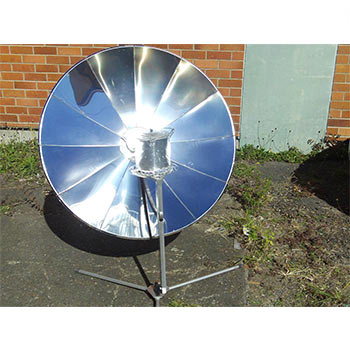
UV rays that are concentrated like this can reach unbelievably high temperatures of 500-700°F (260-371°C). This is more than enough even for grilling and frying. You can even make popcorn.
4. Tube Cookers
Tube cookers are the latest type of solar stoves that appeared on the market. However, they are quickly becoming popular by proving their advantages.
The heart of this type of solar oven is a large evacuated glass tube that is surrounded by shiny reflector panels.
The evacuated tube can reach temperatures up to 550°F (290°C) or even greater. This is enough for roasting meat and vegetables, as well as baking bread and desserts.
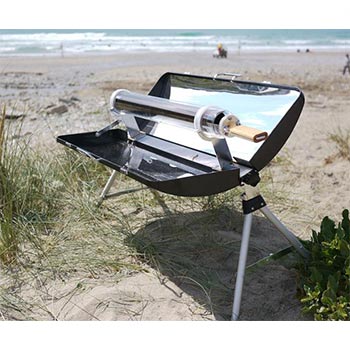
A great advantage of tube cookers over the other types is that they work well even under cloudy skies.
How Does A Solar Stove Work?
A solar stove works by converting the sun’s energy into heat, unlike most solar products that use photovoltaic panels to convert the sun’s energy into electricity.
To achieve this, solar stoves have components that concentrate, absorb, and retain heat.
The first components are metal or metallic foil reflectors, panels, and other reflective surfaces. It’s their job to direct the sunlight to a concentrated point, which is usually a black insulated vessel.
These reflectors are placed all around the oven to speed up the heating.
The cooking pot should be dark-colored because dark colors absorb heat more easily. Also, it helps if the pot is thin, so it can transfer the heat to the food faster and more evenly.
Now the stove needs to trap the heat. Since solar ovens need to be well-insulated to achieve the “greenhouse effect,” the heat trap is transparent. It can be a cooking bag, a glass bowl, or something like that.
If you’ve ever entered a car that has been sitting outside for a few hours on a sunny summer day, you already know how this process works.
Now imagine your car in the same spot, surrounded by large reflecting mirrors.
Ouch!
Apart from trapping heat, the transparent cover allows more sunlight to reach the cooking port and raise the cooking temperature.
This is why you should always make sure the oven has a continuous supply of the sun’s energy to reflect, convert, and absorb. This means you need to adjust the solar stove constantly.
Read More:
Who Would Benefit From A Solar Stove?
People Who Live Off The Grid
Solar stoves are perfect for people living off the grid. With the lack of a power grid, the only source of energy for people comes from renewables and fossil fuels. Solar panels are becoming cheaper every day, and their efficiency is increasing.
However, preparing food with heat consumes a lot of electricity, which portable panels still can’t deliver.
This is where solar cookers come in. They use the same energy source like solar panels, but much more efficiently for the given purpose of generating high heat.
Campers And Hikers
Solar cookers come in several different configurations and if you get a camp stove, you can carry it in a backpack or at least strap it to your rig.
Free cooking using solar power has many advantages over other ways of cooking in the wilderness.
First, you don’t have to forage for dry twigs and branches, which can be an impossible task after the rain. A camp stove works the same just after the shower as it would on a bright sunny day. Second, you can save yourself from the fire hazard that comes with cooking on an open flame.
Preppers
Solar cookers are also popular among people who like to be prepared for whatever comes next, be it a massive blackout pulse from outer space or the zombie apocalypse.
Funny references aside, in emergencies such as state-wide power failures, storms, floods, and other extreme weather events, hot food can mean a lot.
So whether you’re preparing for the day the deadly machines will take over or simply want to be prepared for the next natural disaster, a quality solar stove should have a place in your bail-out kit.
Eco-Conscious Folks
Finally, solar ovens benefit people who care about the environment and are always looking for ways to reduce their carbon footprint.
Instead of using your gas stove or electric oven day after day, why wouldn't you all gather in the backyard, deploy your camp stove, and have quality time in fresh air while the sun cooks your dinner?
After all, you should keep in mind that apart from serving valuable resources, a solar oven can help you with your electricity bills. Solar cooking uses literally zero electrical power and contributes to zero emissions.
Benefits Of Using A Solar Stove
Clean Energy
Solar cooking is the cleanest and most environmentally friendly way of preparing food known today. It uses only the power of the sun, while physics does all the rest.
Its alternatives are much more unacceptable in the environmental sense. For example, wood or coal stoves leave nasty byproducts like soot and ash, not to mention the CO2 and other residues that are dispersed into the atmosphere.
Using a propane camp stove might be a bit greener, but natural gas is also considered a depletable resource that also needs a lot of energy to extract, refine, and transport.
Portable
Dragging fuel for a traditional stove or grill while camping really beats the idea of traveling light, not to mention self-sufficiency and living off the land. Thanks to their compact size and small weight, solar camp stoves are easy to pack and deploy wherever you need a hot meal.
Unlike their counterparts that use wood or coal, solar cookers like the GoSun Grill are perfect for situations where apart from available space, weight is luxury, as well. If you can take one stove on a 30ft sailing boat for a 20-day journey, would it be a solar stove or something else?
Easy To Clean
A solar camp stove does not use gasoline or any other fuel that produces soot, so it’s much easier to clean than its dirty-technology counterparts. The only thing you need is soapy water and a cloth to wipe any food or grease that might have gotten stuck to the reflecting panels.
Easy cleaning can also be time-saving, especially if you’re enjoying the great outdoors and have a lot of activities to attend to.
Since nothing is burned, you also don't have to deal with ash and embers that always pose a risk in the wooded areas where the ground is bristling with pine needles or dry leaves.
Healthy Meals
Solar ovens cook food more slowly so it retains its flavor. For example, meat is more tender and nutritious compared to regular ovens. Because of the solar trap, these ovens are also great for retaining the moisture in your food.
When you use a solar stove, it’s practically like a slow cooker that uses free solar power instead of electricity. If, for example, you’re using a solar camp stove that cooks at 180°F (82°C), you can rest assured that the food or water is free from microorganisms that chase disease.
And since the food cooks gently at temperatures lower than in regular ovens, it retains the nutrients and rarely overcooks or burns.
Temperature Adjustment
At a regular oven, it's easy to adjust the temperature — just turn the knob and set the heat that you need. But did you know that you can easily adjust the temperature on a solar cooker as well?
When using a solar camp stove, you can regulate the temperature in several ways. You can lower the temperature by taking it out of the sun, opening the door of the cooking area, or closing up the main sun catcher panels.
To raise the temperature, you only need to make sure your solar camp stove is oriented directly to the sun.
Safe And Easy
A great thing about solar ovens is that you need to prepare the ingredients and put them inside. No other prep work needed. What is more, since solar stoves don't burn any fuel, you don't have to worry about open flames or burns.
This feature makes solar ovens great for folks with children or pets as well as busy families.
Another benefit of solar cooking is that you don't have to monitor the food constantly. Just put everything in and you can go about your business.
Great For Remote Areas
Lastly, a solar oven is a valuable resource in areas that experience limited access to fuel and electrical power. Whether you’re camping on the banks of the Yukon or in the Mojave desert, it’s absolutely the same for your solar camp stove.
More importantly, solar stoves are easy to build which makes them attractive for low-income communities that may have difficulties accessing fuel or electricity.
Disadvantages Of A Solar Stove
Like all devices that run on solar power, solar ovens need sunlight to work. This makes them less useful during winters when days are shorter, and absolutely useless at nighttime.
They are also not recommended for those living in cold climates, as the cold air can negate the heat accumulated by the reflectors.
A solar oven might not be of much use during storms, while on overcast days only tube cookers can generate enough heat.
Also, since the success of cooking depends on a lot of sunlight, some people might find it annoying having to constantly adjust and reorient the device.
Other users might be put off by the long cooking time when compared to a regular oven. With solar ovens, you need to prepare and start cooking your meal early in the morning. This can be inconvenient for people who have busy working schedules.
FAQ
Yes, solar power can run a stove. Solar camp stoves are designed to reflect available sunlight into a heat trap in the center of the oven, where you place the cooking dish. Quality solar stoves can cook pretty much everything a regular stove can.
Yes, solar ovens really work and can be successfully used for preparing a variety of meals and hot drinks. They are 100% environmentally-friendly because they don't burn any fossil fuels but run on solar power only. They are especially popular among people living off the grid.
No, we can’t use a solar cooker at night. Solar cookers depend on continuous sunlight supply to work, so they are completely useless after dark. Portable solar ovens that use vacuum tubes, can however work under cloudy skies and less-than-ideal sunlight conditions.
Yes, you can boil water in a solar oven. You can bring water to boil in all types of solar ovens. However, not many people know that to make water safe to drink you only have to pasteurize it, not necessarily sterilize. You can pasteurize water by heating it to 149°F (65°C) for 6 minutes.
You can cook a wide variety of foods and hot drinks in a solar oven. It mainly depends on the oven type and the temperature it can achieve and hold. Basic solar ovens can brew coffee, cook soups, stews, and casseroles, while more advanced ones can even grill and fry.
The success of solar cooking is affected by the available sunlight and the adjustment of the solar oven. Most portable solar ovens need plenty of the sun’s energy to cook food evenly and within a reasonable time frame. This means that you need to adjust your solar oven so it always faces the sun directly.
It depends on the oven type. Solar box ovens typically reach temperatures around 300°F (150°C), which is enough to cook most foods. Parabolic solar ovens, like GoSun solar products, on the other hand, are more efficient and can reach a temperature of about 500°F (260°C).
Solar cooking takes longer than a regular kitchen oven because the temperature isn't as high or as constant. As a rule, the same recipe takes 1.5-3 times longer in a solar oven. The practical cooking time depends on the type of oven, weather, type of cookware, type of food, etc.
It depends on the type of oven. Panel ovens are considered the least efficient and may not give satisfactory results on cloudy days. Parabolic and tube cookers reach much greater temperatures and will be able to cook on cloudy days, as well.
You can make your solar oven faster by using a dark cooking vessel, as dark colors help absorb the heat more easily. You should also use a vessel that is thin, so it transfers the heat to the food more quickly and evenly.
My Recommended Solar Stove
Portable solar stoves have evolved a lot in the last couple of years, with each design trying to minimize its shortcomings and maximize the perks.
Still, if I had to recommend one solar stove only, my vote goes to GoSun Fusion. Not only is it the best all-arounder, but it cooks food in 20 minutes — significantly faster than any other product I tested.
Also, despite the amazing temperature range, this all-season solar cooker stays cool even in the midday sun.
And I love the fact that it’s so portable and I can wipe it easily and throw it into my backpack. You can’t go wrong with this for sure.

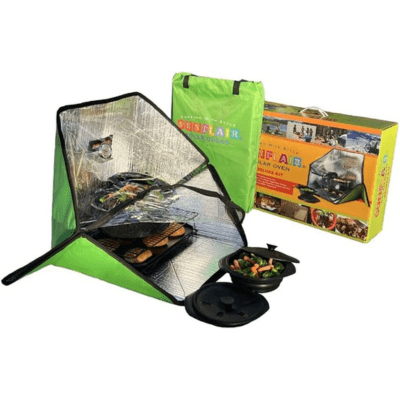

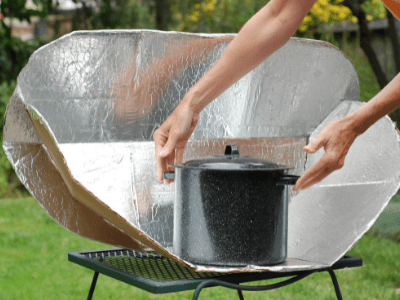









Great article, thanks. I especially enjoyed the information that came after the reviews. I did own one of the tube cookers, and there were strict instructions not to preheat. Seems that a preheated tube is not compatible with cold food or cookware. Thermal shock shatters the tube, according to manufacturer.
I have tried the glass tube vs. panel vs box cookers. IMHO, panel cookers have the best capacity, are the most rugged (no glass) and lightest weight.
Great choice on the Haines and the SolCook.
This blog post from GreenCitizen introduces an exciting and sustainable solution in the form of a solar stove. The article explains the concept of harnessing solar energy for cooking, reducing reliance on traditional fossil fuels and minimizing the environmental impact.
Thanks for this, Nikola. You have done a good comprehensive review of solar cookers. This is great news for the promotion of solar cooking.
Just a couple of things I would like to point out.
Firstly, you can (and people do) use solar cookers in cold countries. I am in the UK, over 50degN, and it’s perfectly possible to cook at any latitude (including in the Arctic Circle) if the sun is out. As you say, evacuated tube cookers are the most efficient, and I can regularly use one to bake bread when the ambient temperature is below zero, as long as the sun is out. I wouldn’t want readers in the colder countries to be put off trying solar cookers.
Secondly, people insist on mentioning the concentration of UV when they explain how solar cookers work. But, as an engineer, you will know that less than 3% of the energy in the solar spectrum that reaches sea level is due to UV. It’s a tiny proportion of the power available, and solar cookers can utilise the whole of the solar spectrum, down into the near infra-red. In fact, around half of the power that drives a solar cooker is in the near infra-red.
Dave
Pingback: 9 Actionable Tips For A Sustainable 4th of July Celebration - GreenCitizen
Hi,
It is a great job you did solar stove
May I become your agent?
That we can work together and if you read my book titled The Developers that I relate solar energy for speeding sustainable development goals at homes on the world.
Please helpe do it together. Your product is good for subsaharan countries. Send one and I will show it and we need here in Eritrea.
Fitsum Amaha
Thanks for a marvelous posting! I definitely enjoyed reading it.
During those times when I do not have instant access to my kitchen or need to cook outdoors, or survive living in the wild, solar stove can be my go-to.